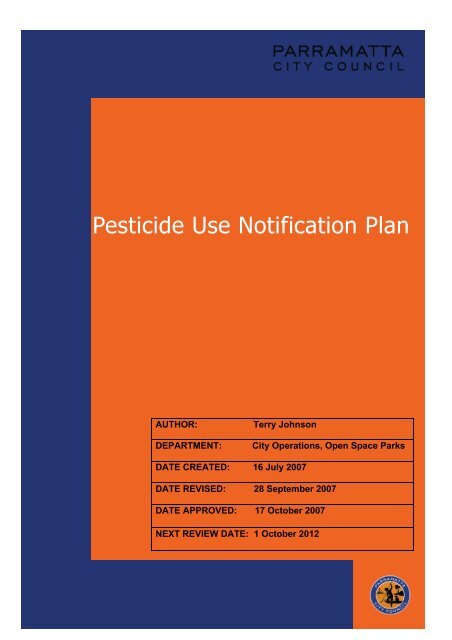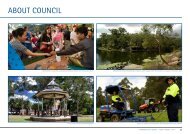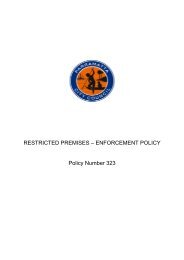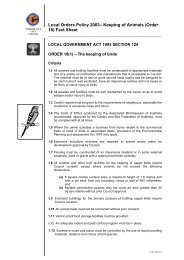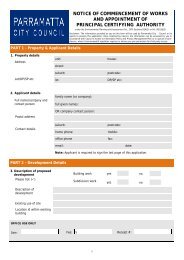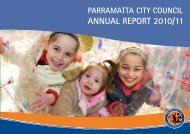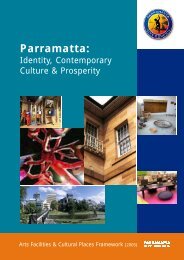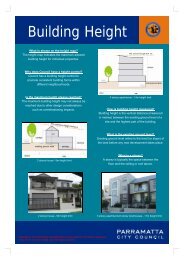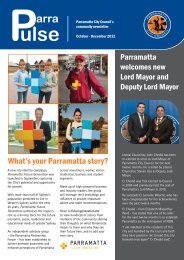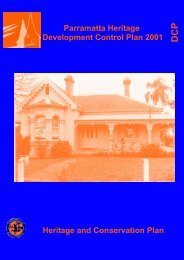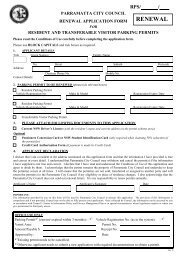Pesticide Use Notification Plan - Parramatta City Council
Pesticide Use Notification Plan - Parramatta City Council
Pesticide Use Notification Plan - Parramatta City Council
You also want an ePaper? Increase the reach of your titles
YUMPU automatically turns print PDFs into web optimized ePapers that Google loves.
Plac e your mes sage here. F or maximum i mpact, us e two or thr ee sentences.Heading<strong>Pesticide</strong> <strong>Use</strong> <strong>Notification</strong> <strong>Plan</strong>AUTHOR:Terry JohnsonDEPARTMENT: <strong>City</strong> Operations, Open Space ParksDATE CREATED: 16 July 2007DATE REVISED: 28 September 2007DATE APPROVED: 17 October 2007NEXT REVIEW DATE: 1 October 2012
PESTICIDE USE NOTIFICATION PLANFOR PARRAMATTA CITY COUNCIL1. INTRODUCTIONThis pesticide use notification plan has been prepared in accordance with therequirements of the <strong>Pesticide</strong>s Regulation 1995 (the Regulation).The aim of this plan is to meet the community’s general right to know aboutpesticide applications made to outdoor public places that are owned or controlled bypublic authorities. The plan allows members of the community to take action toavoid contact with pesticides, if they wish.<strong>Council</strong> ensures that pesticides are applied to public places in a safe, responsiblemanner, minimising harm to the community or the environment. <strong>Council</strong> iscommitted to ensure that pesticide use is justified and that the lowest toxicity ofpesticides necessary are applied to achieve the desired outcome.The plan sets out how <strong>Council</strong> will notify members of the community of pesticideapplications made by <strong>Council</strong> and its contractors to public places.The plan describes:• What public places are covered by the plan• Who regularly uses these places and estimate of the level of use• How and when <strong>Council</strong> will provide the community with information about it’spesticide applications in public places (ie; what notification arrangements willbe used)• How the community can access this plan and get more information about<strong>Council</strong>’s notification arrangements• How future reviews of the plan will be conducted• Contact details for anyone wishing to discuss this plan with <strong>Council</strong>.
<strong>Council</strong> only uses pesticides in public places, when necessary, to eliminate noxiousweeds, assist in the maintenance of council assets, to protect property from pestdamage and to protect the users of public places from nuisance or danger. Wherepossible and practical, alternative control methods will be used to limit the need forthe application of chemical pesticides.2. PUBLIC PLACES COVERED BY THIS PLAN<strong>Council</strong> proposes to use or allow the use of pesticides in the following categories ofoutdoor public places within this <strong>Council</strong>’s local government area:• Parks & public gardens includingo Playgroundso Picnic and barbecue areaso Street closures and other green open space• Sporting fields and ovals includingo Golf courseso Tennis courts• Roads, lanes, paths and verges includingo Street Treeso Street Tree bases and squares• Bushland reserves• Drains and easements• <strong>Council</strong> buildings and surroundsA summary of public place categories, user groups, level of use pesticides used andnotification methods is provided in table form in Appendix A.3. NOTIFICATION ARRANGEMENTSThis section of the plan describes how and when <strong>Council</strong> will provide notice ofpesticide use in public places. These notification arrangements are based on<strong>Council</strong>’s assessment of:• The level of usage of public places where pesticides may be used• The extent to which members of the public who are most likely to besensitive to pesticides (eg; young children, sick, pregnant and elderly people)and are likely to use these areas regularly• The extent to which activities generally undertaken in these areas could leadto some direct contact with pesticides (such as picnic areas where food isconsumed, sporting or other recreational activities that result in contact withthe ground)• The type of pesticide used<strong>Parramatta</strong> <strong>City</strong> <strong>Council</strong> <strong>Pesticide</strong> <strong>Use</strong> <strong>Notification</strong> <strong>Plan</strong>.Final 28 September 2007 V.3 1
Notice of pesticide use will be provided by one or more of:• Signs• Letters• Fax or email• Letterbox drops• Door knocking• <strong>Council</strong>’s website• Notices to registered or approved park usersEXEMPTIONS TO NOTIFICATION<strong>Council</strong> uses small quantities (up to 15lt of mixed solution) of some pesticides thatare widely available in retail outlets and ordinarily used for domestic purposes(including home gardening). <strong>Council</strong> does not intend to provide notice for suchpesticide applications other than by way of this description in this plan (or generalinformation on <strong>Council</strong>’s website).This will also apply to minor control of indoor andoutdoor pests using baits or aerosol spray cans and spot weed control using a wandor hand-held applicator.<strong>Council</strong> provides small amounts of rodenticide to ratepayers and local residents ona quarterly basis. A register will be kept listing:• Name and address of the person collecting the rodenticide• Quantity and type of pesticide supplied• Date supplied• Notice that the pesticide is not to be used in a Public Place• Notice that application must be in accordance with manufacturersinstructionsSPECIAL MEASURES FOR SENSITIVE PLACESClause 11J (1) of the <strong>Pesticide</strong>s Regulation defines a sensitive place to be any:• School or pre-school• Kindergarten• Childcare centre• Hospital• Community health centre• Nursing home• Place declared to be a sensitive place by the Environment ProtectionAuthority (EPA) – now a department of Environment and Conservation(DEC).<strong>Parramatta</strong> <strong>City</strong> <strong>Council</strong> <strong>Pesticide</strong> <strong>Use</strong> <strong>Notification</strong> <strong>Plan</strong>.Final 28 September 2007 V.3 2
<strong>Notification</strong> of pesticide application adjacent to sensitive areas, as previouslydefined, will take place when pesticide application is:• In line with those listed in Table 1 requiring notification• When the application area is within thirty meters of a sensitive place<strong>Notification</strong> is to be provided in writing to the relevant operators of the place at leastforty eight hours prior to pesticide application.If a pesticide must be used to deal with an emergency in an outdoor public placethat is adjacent to a sensitive place, <strong>Council</strong> will organise a door-knock in thatsensitive place, preferably at least 30 minutes before, so people are aware that apesticide is about to be used to deal with a dangerous pest infestation.EMERGENCY PESTICIDE APPLICATIONSIn cases where emergency pesticide applications are required (not adjacent to asensitive place), <strong>Council</strong> will provide notice by posting signs nearby at the time ofapplication. If this is not possible, <strong>Council</strong> will provide information via CustomerService or by request to the person applying the pesticide.PESTICIDE CONTRACTORS AND LESSEES OF PUBLIC PLACESWhere <strong>Council</strong> uses contractors to apply pesticides on its behalf, <strong>Council</strong> willensure that notification is made in accordance with the notification requirements ofthis plan.Lessees of public places and or <strong>Council</strong> facilities will comply with this plan4. WHAT INFORMATION WILL BE PROVIDEDIn Accordance with clause 11L (2) (g) of the pesticide regulation, notices ofpesticide use must include all the following information:• The full product name of the pesticide to be used• The purpose of the use, clearly setting out what pest or pests are beingtreated• The proposed date/s or date range of the pesticide use• The place where the pesticide is to be used• Contact telephone number and email address of the council officer whopeople can contact to discuss the notice• Any warnings regarding re-entry to or use of the place of applicationspecified on the product label or the Australian <strong>Pesticide</strong>s and VeterinaryMedicines Authority permit.Signs will be of a standardised design that will be easily recognisable to the publicand workers.<strong>Parramatta</strong> <strong>City</strong> <strong>Council</strong> <strong>Pesticide</strong> <strong>Use</strong> <strong>Notification</strong> <strong>Plan</strong>.Final 28 September 2007 V.3 3
As already noted, <strong>Council</strong>s website will have a dedicated area that describes itsprogrammed, reactive and if practicable emergency pesticide use in public placeswith a link to this notification plan5. HOW THE COMMUNITY WILL BE NOTIFIED OF THE PLAN<strong>Council</strong> will advise residents of the contents of the plan and its contents by:• Making a copy of the plan available for public viewing free of charge in<strong>Council</strong>’s libraries and main office during office hours• Placing a copy of the plan on the <strong>Council</strong> website atwww.parracity.nsw.gov.au.• Placing a notice in the local newspaper6. FUTURE REVIEWS OF THE PLANThe notification plan will be reviewed every five years, or when circumstancesrequire a review of the plan. The review will include:• A report on progress of implementing the plan• Placing the plan on public exhibition, with any proposed changes and callingfor public submissions• In the light of public submissions, making recommendations for alterations (ifapplicable) to the plan7. CONTACT DETAILS FOR FURTHER INFORMATIONAnyone wishing to contact <strong>Council</strong> to discuss the notification plan or to obtaindetails of pesticide applications in public places may contact:Service Manager - Parks<strong>City</strong> OperationsTel: 88394021Email: tjohnson@parracity.nsw.gov.au<strong>Parramatta</strong> <strong>City</strong> <strong>Council</strong> <strong>Pesticide</strong> <strong>Use</strong> <strong>Notification</strong> <strong>Plan</strong>.Final 28 September 2007 V.3 4
PESTICIDE USE NOTIFICATION PLANAPPENDIX A
Public Placesowned orcontrolled by<strong>Parramatta</strong> <strong>City</strong><strong>Council</strong>Public Parks &Gardens including• Playgrounds• Picnic &barbecueareasSporting Fields, golfcourses and otherrelated SportingFacilitiesAPPENDIX A : Table 1 – Summary of Place Categories and <strong>Notification</strong> ProceduresRegular user Level of use of Type of pesticide Method ofWhen notificationgroupspublic place usenotification will take place• Children andyoung families• Elderly people• Generalrecreationalusers(Joggers,walkers,picnickers).• Other socialgroups• Sporting Clubsandassociations• School Sportsgroups• Generalrecreationalusers• Casual sportshirersHigh to very highFrequent short tomedium durationLonger duration onweekends andschool holidaysHIGH – as persporting seasonsand schedules• Spot sprayingnon-selectiveherbicides• Broadscaleselectiveherbicides• Insecticides –contact andsystemic• Rodenticides• Spotherbicides• Spotinsecticides• Broadscaleselectiveherbicides• Broadscalepre-emergentherbicides• Broadscaleinsecticides• Fungicides• Rodenticides• Signage 24hours prior toapplication inprominentlocationsadjacent to thetreatment area• Signs toremain in place24 hours afterapplication• Signage 24hours prior toapplication inprominentlocationsadjacent to thetreatment area• Signs toremain in place24 hours afterapplicationFor application ofselective herbicidesONLYFor the applicationof :• Broadscaleselectiveherbicides• Broadscalepre-emergentherbicides• BroadscaleinsecticidesAppendix A. <strong>Parramatta</strong> <strong>City</strong> <strong>Council</strong> <strong>Pesticide</strong> <strong>Use</strong> <strong>Notification</strong> <strong>Plan</strong>. Final 17October 2007 V.2 Page 1 of 2
Roads, Laneways,Pathways, Naturestrips,Easements &Drains, StreetScapesBushland reservesand other naturalareas<strong>Council</strong> Buildings(external) andsurrounds• Public – Localresidents andvisitors• Walkers,cyclists ordrivers• Generalrecreationalbushwalkers• Volunteer BushCare workers• Library users• Communitygroups/associations• Employeesand visitors• Members ofthe publicMedium to high • Spot nonselectiveherbicidesLow • Spot nonselectiveherbicides• Broadscale nonselectiveherbicides• Termiticides• Large VertebratebaitingHigh to very high • Spot Insecticides• Spot herbicides• Dust, LiquidResidual sprayand baitTermiticides• Dust, LiquidResidual sprayand Baitinsecticides• Bait bird control• Rodenticides• <strong>Notification</strong> viathis plan only• Signagedisplayed attime ofapplication• Signs toremain in place24 hours afterapplication• LargeVertebratecontrol – asper NPWSguidelines• Signagedisplayed attime ofapplication• Signs toremain in place24 hours afterapplicationOngoing by internetFor the applicationof :• Broadscaleselectiveherbicides• LargeVertebratecontrol – asper NPWSguidelinesFor the applicationof :• Dust, LiquidResidual sprayand baitTermiticides• Dust, LiquidResidual sprayand Baitinsecticides• Bait birdcontrolAppendix A. <strong>Parramatta</strong> <strong>City</strong> <strong>Council</strong> <strong>Pesticide</strong> <strong>Use</strong> <strong>Notification</strong> <strong>Plan</strong>. Final 17October 2007 V.2 Page 2 of 2


